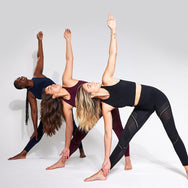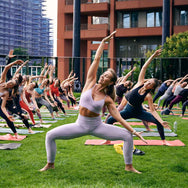
It’s no secret lockdown has inspired many to lace up running shoes for the first time - or for many, the first time in a while. It’s a great outlet for keeping fit and expanding surroundings in lockdown beyond your residence and nearest grocery store. But how can you improve on this new hobby you’ve started? If you’re new to running, and you’ve been building up the miles gradually, you may eventually come to a bit of a plateau where you can comfortably reach what were once benchmark distances, but have trouble going any faster while you pound the pavement.
Just like building distance and stamina, speed in running takes a tailored training approach. Read on for a simple and effective speed work set for runners.
WHAT ARE SPEED INTERVALS?
Speed intervals are a repeated set of a fixed short distance or distances on a track. They’re designed for you to push your pace, briefly recover, and try to bring consistency to the same segment again. This practice helps train your fast-twitch muscle fibres which provide power in bursts of movement like sprinting.
Interval training is also great for building stamina across varied distances, which ultimately helps increase your overall pace whilst running. Not only do intervals help you learn how to keep consistent pacing so that you don’t burn out early, they’re also great for tracking your developments as a new runner as you attack the same intervals on different days.
SPEED SET FOR BEGINNERS
For this speed set, we’re going to a pyramid interval of 400 meters, 800 meters, 1600 meters, 800 meters, 400 meters. A pyramid set is a fantastic format for firing up those fast-twitch muscle fibres we mentioned before, while also incorporating some endurance over the longer stretches. This mix of fast and controlled is the ultimate approach learning how to build speed and adjust pace over distances.
But before we dive in, it’s important to warm up.
WARM UP FOR INTERVAL RUNNING
To kick off your warm up, start by jogging around your 400m loop a few times. This pace should be deliberately slow, as you don’t want to tire yourself before the main set.
After a light jog to warm up, it’s important to stretch to prevent injury. Running is essentially made of two elements: stride length (how long each step is) and cadence (how many steps you take). An effective warm up will include drills that improve both of these.
When you’re ready, try these dynamic drills to train up muscle memory and improve your running form to increase speed. Practice these for about 10 meters before jogging back to your starting point.

DYNAMIC DRILLS FOR RUNNING
-
Lunge walks: this is basically a deconstructed lunge. To start, step one foot in front of you in an exaggerated motion. Drive your knee up, as you do, drive the arm and elbow on that side back, kick your forward foot out and slowly bring it down only as far as you can before you start wobbling. This engages your core and enhances your stride length. Ensure your knee does not go further than your planted foot. As you lunge, it should be a downward motion, not forward beyond your foot. Then lunge forward with your other foot, so that you slowly progress across 20m.
-
Rhythm Skip: this drill helps your hip flexors, flexibility, and stride length. Drive your knee up into a high knee position just for a moment, before landing on your forefoot or balls of your feet. Repeat the same on the other side, skipping you forward. You can bring your arms above your head in a clapping motion as you go, or propel your elbows back if you want to work on your upper body running form. This drill promotes good torso and pelvic positioning.
-
High knees: now, get your knees as high up as you can as quickly as you can. It’s not about going far with these steps. This drill improves your cadence, or how many steps you take while you run. This increased turnover from these high knee drives will carry over into your running form.
-
Butt kicks: this is a drill most people are familiar with. With each step, snap your foot back so it touches your glutes. This drill keeps your muscles flexible and ready for running.
-
Fast feet: these fast feet are an exaggeration of the strides you make when you run. This is another drill that focuses on improving your cadence. In a forefoot position take as many quick steps as you can while driving your quads up and elbows back just as you would in an otherwise normal running position. Keep your chest up, and focus on taking several quick short steps, rather than moving forward fast.
-
Strides: now it’s time to put all this practice in motion. A stride is a 100 meter run at about 70% effort. This is an opportunity to focus on an element from the drills we just completed, and carry the conscious motion into your technique. When put to practice enough, you won’t even have to think about it, your body will remember what to do. Do about 4 strides before toeing up for the main set.

400-800-1600 PYRAMID SPEED INTERVAL
Many local recreation centres have reopened their track and field facilities. If there’s one near you, a track would be favourable as it offers a precisely measured environment for training. If you don’t have a track near you, no worries, simply head to your favourite local park and make a loop for yourself that is about 400 meters around.
As the name suggests, this set is structured as if you’re going up and down a pyramid. The set starts with a hard interval of 400m (one lap around the track), progressing to 800m (two laps around the track), and peaking at 1600m (four laps around the track) before coming back down to 800m, and 400m once more as you descend the pyramid.
Each interval should be approached at your 5K race pace. If you don’t know your 5K pace yet, it should be a push, but not a flat sprint. Try to hit a pace that feels like a challenge, but one you can sustain for 20 or so minutes. Be aware that while the overall goal is to build consistency, you may (and probably should) approach each distance a little differently. For example, you wouldn’t want to burn out on your 1600m by starting too fast on the first lap.
The Pyramid Set
- 400m (1 lap) at 5K pace
- 60sec recovery (standing or active recovery)
- 800m (2 laps) at 5K pace
- 90sec recovery (standing or active recovery)
- 1600m (4 laps) at 5K pace
- 120sec recovery (standing or active recovery)
- 800m (2 laps) at 5K pace
- 90sec recovery (standing or active recovery)
- 400m (1 lap) at 5K pace
- BONUS: extra 400m finisher if you’re feeling up for it!
Be sure to finish with a 5 minute slow jog to cool down followed by a good stretch session.

CONCLUSION
Interval sessions are a fantastic structure to develop your performance as a runner. They’re great for learning how to control a consistent pace, and it’s the number one technique you can use to improve your speed. The idea of toeing up at a track, can sometimes intimidate new runners, but with these tools you’ll have the savvy and the drills to keep you cruising lap after lap. Be sure to bring some water with you!






























































